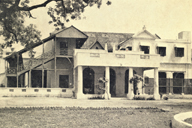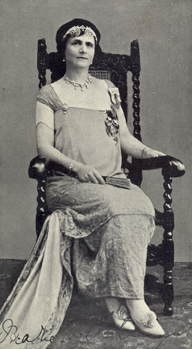|
Chances are that you would never have heard of the Ladies’ Recreation Club. But, at a time when most clubs of Madras were for men only, it was the one place where women could unwind. Even today, there are several women of the city who remember it fondly and recall the facilities it provided.

The Willingdon – home of the Ladies' Recreation Club |
The LRC owed its origins to a few European women of Madras who had a genuine desire to mix with their Indian counterparts and be able to understand them. In August 1911, at the joint initiative of Mrs. Madeley, wife of the Engineer of the Madras Corporation, Mrs. Seethamma Tiruvenkatachariar (daughter of Sir V. Bhashyam Iyengar, the eminent lawyer and judge, and wife of C.R. Tiruvenkatachariar, a well-known lawyer) and a Mrs. Subramaniam, the Club was formed with the objective of “promoting social and friendly intercourse between European and Indian ladies and between Indian ladies of all classes and creeds; also to provide healthy recreation suitable to the members of the club.”
The Club’s first home was the garden of Sylvan Lodge, a bungalow in Mylapore and the property of Justice Sir David M. Devadoss. His wife, Lady Masilamoney Chellammal, who was to later play an important role in the education of women and also be a Councillor of the Corporation, took an active interest in the Club. The annual subscription was fixed at Rs. 5 and the Club met every Friday. The first committee comprised Mrs. Ayling (wife of Justice W.B. Ayling of the High Court), Mrs. A. Davies (wife of Arthur Davies, ics), Mrs. Glyn Barlow (her husband was in the Department of Education and wrote the book The Story of Madras), Miss C. Lynch (later Mrs. C. Drysdale, an Inspectress of Schools), Lady Desikachari (wife of Sir V.C. Desikachari, a legal luminary), Mrs. (afterwards Lady) Sankaran Nair (wife of Sir C. Sankaran Nair, Judge, High Court of Madras), Mrs. T.V. Seshagiri Iyer (wife of Justice Seshagiri Iyer of the High Court of Madras) and Mrs. Seethamma Tiruvenkatachariar. The Club’s first secretaries were Mrs. Subramaniam and Mrs. Madeley. In what became a convention later, Lady Carmichael, wife of the then Governor of Madras, was made the President.
The first facilities that the Club offered were badminton and croquet. Then came tennis and it must have been a quaint sight to see women clad in nine-yard sarees playing with others in skirts.

Lady Willingdon. |
By the end of the first year, the Club saw an enormous increase in membership. Donations were solicited and the Maharani of Pithapuram gave Rs. 1000. The Club began meeting twice a week – on Tuesdays and Fridays. In 1913, it moved to The Luz, a bungalow that still stands on Oliver (now Musiri Subramania Iyer) Road, belonging to S. Srinivasa Iyengar. It was here that it hosted a reception to Winifred, Lady Hardinge, the Vicerine. The distinguished visitor, on her return to Delhi, sent a cheque for Rs. 300 and with that the Lady Hardinge Library was begun by the Club.
During the Great War, the Club members collected money for the war effort and assisted the Red Cross by sewing, knitting, crocheting and rolling bandages. At the end of the War, the Club’s fortunes moved into fast gear with a new and dynamic First Lady taking over at Government House. This was Marie, Lady Willingdon, the pushy spouse of a man who, thanks largely to her, had the longest tenure of Government Houses during the Raj, for he was Governor of Bombay, Madras, Governor-General of Canada and Viceroy of India. And during that time, he also moved up steadily in the British peerage, starting off as a lowly Mr. Freeman Freeman-Thomas mp and winding up as the Marquis of Willingdon. Even today, there are several spots, buildings and institutions in India that commemorate his (and her) name. One of these was the Ladies’ Recreation Club.
Lady Willingdon, by virtue of being First Lady of Madras, became President of the Club, and decided that it needed a home of its own. Assisted by Alice, Lady Todhunter (wife of Sir Charles, member of the Governor’s Council) identified and settled a rent agreement for a large property with a bungalow on Marshall’s Road, Egmore. Soon, she decided that only an outright purchase would do and set about collecting the required Rs. 2.50 lakh. S.Rm.M. Annamalai Chettiar (later to be Sir and then Rajah) gave Rs. 2 lakh, the Maharajah of Travancore Rs. 25,000 and the Rajah of Bobbili Rs. 10,000. The balance was made up by donations from members and, within the year, the property was purchased. A pre-condition for Annamalai Chettiar’s donation was that the Club building ought to be named after the Willingdons and this was done.
The Club was by this time meeting three days in a week and it was decided that on the remaining days it could be let out for social functions, in order to get some rent. The Indian National Association, a mixed club for Europeans and Indians, met at the premises one day each month.
It was the First Lady’s considered view that women could not manage the property by themselves and so the entire ownership was transferred to the Willingdon Trust, which had as its trustees the Governor of the Province, the Administrator-General and the Secretary of the Imperial Bank (later State Bank) of India. The trust deed was drafted by the Willingdons’ good friend and member of the Governor’s Executive Council, Sir C.P. Ramaswami Aiyer. The Trust administered the property through a Council, the first members of which were Sir Arthur Knapp (Secretary, Government of Madras), Sir C.P., Mrs. (later Lady) Wright (wife of a senior member of Parry’s), Mrs. C.V. Krishnaswami Chetty (whose husband was Electrical Engineer at the Corporation and is still better remembered for introducing radio to Madras), Mrs. Madeley, Mrs. Ian Fraser, Mrs. Zynuddin (wife of the then Judge of the Small Causes Court), Alexander McDougall (of Simpson & Co) and Raja Raghava Varma.
Lady Willingdon participated in all the Club’s events with gusto. Savitri Rajan, daughter of Dr. T. Sitapathi Iyer of the King Institute, remembered a table tennis tournament at the Club. She, very much a young girl then, had made it to the finals and it was with a sinking feeling that she came to know that the other finalist was Lady Willingdon! The youngster’s confidence was not helped in any way by the fiercely competitive First Lady arriving at the Club a day earlier and asking for a practice session. “Her standard was so high,” wrote Savitri many year later. The ladies of the Club, however, encouraged her. The finals were played and Savitri lost. But it was customary that the First Lady could not accept a trophy and it was awarded to Savitri in the end.
Lady Willingdon also introduced the custom of hosting an evening every year at Government House for the ladies of the Club and it was de rigueur for the children to be in fancy dress. Later, it became customary to have two events at Government House – a ladies’ day and a children’s day. Writing many years later about the Children’s party, Mona Hensman (wife of Dr. H.S. Hensman of the Mental Health Hospital, Ayanavaram, and later a member of the Madras Legislature and Principal of Ethiraj College) reminisced, “Such lovely entertainments these were, with tables covered with sweets and cakes; magic displays, Punch and Judy shows, and the merry-go-round made the mothers almost as excited as the children.”
While the Club did benefit from the guidance of Lady Willingdon, two other moving spirits were Mrs. Seetha Tiruvenkatachariar and Miss Gerrard. Seetha, or Seethakka as she was better known, was described as the guardian angel of the Club. Miss Gerrard joined at the end of the Great War as a paid secretary of the Club and it benefited greatly from her guidance. Being fond of children, she allotted two Mondays a month as Children’s Days and, later, this became a weekly Friday feature. Open to children up to the age of 14, the Club had see-saws, rocking horses, swings, tri-cycles and a vast playground for their recreation. If it rained, the Lady Hardinge Library was thrown open for indoor games. Though in later years rather restricted in her mobility, Miss Gerrard continued to be active in Club affairs till she retired and returned to England after a sorrowful farewell in 1945. She lived to a ripe old age, being well enough to send a commemorative message in 1961 when the Club turned 50. The children, however, continued loving the Club long after she had gone. At the age of 12, girls became Family Members and several of them later became full members themselves.
The ice-cream of the Club was a major attraction and it was introduced by Miss Gerrard. When children wanted to stay on for a little longer, dads waiting impatiently in cars could be pacified about it, remembered Shamugasundaram, a boy whose mother had been a member. During the tenure of Miss Gerrard, the Club expanded its activities and remained open on all days of the week.
(To be concluded next fortnight)
|